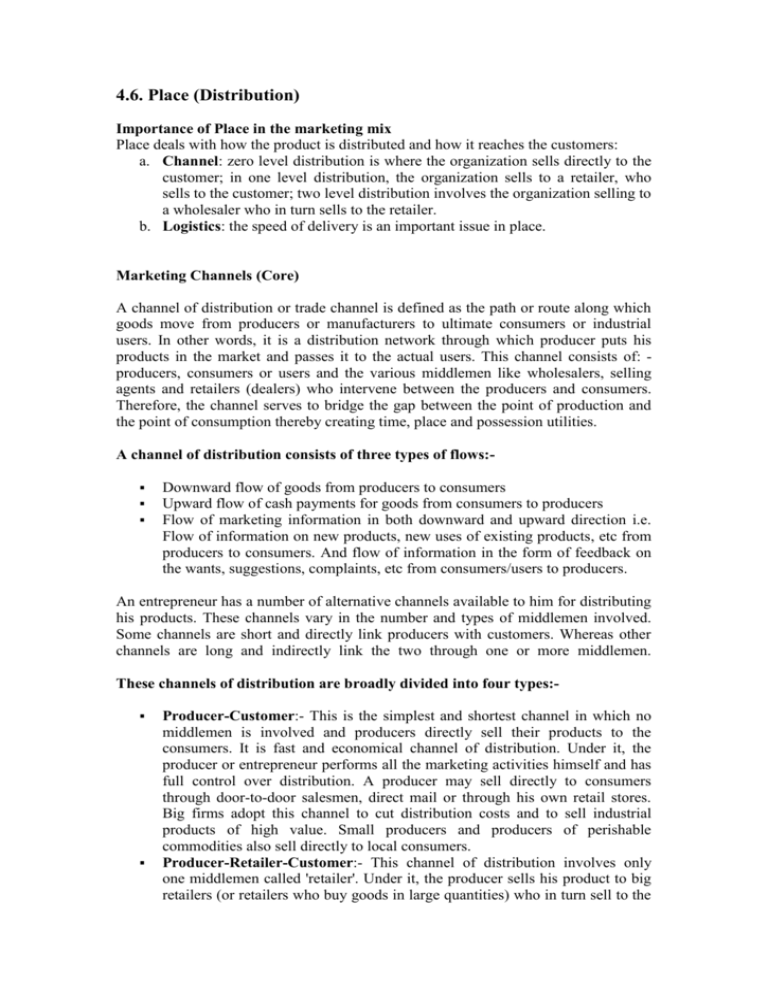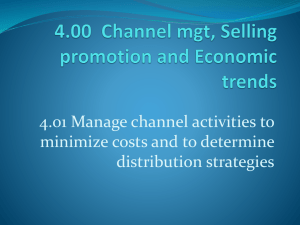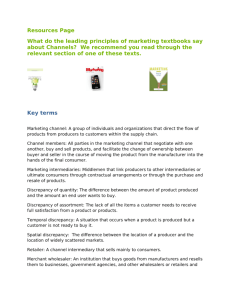File - Mr. P. Ronan
advertisement

4.6. Place (Distribution) Importance of Place in the marketing mix Place deals with how the product is distributed and how it reaches the customers: a. Channel: zero level distribution is where the organization sells directly to the customer; in one level distribution, the organization sells to a retailer, who sells to the customer; two level distribution involves the organization selling to a wholesaler who in turn sells to the retailer. b. Logistics: the speed of delivery is an important issue in place. Marketing Channels (Core) A channel of distribution or trade channel is defined as the path or route along which goods move from producers or manufacturers to ultimate consumers or industrial users. In other words, it is a distribution network through which producer puts his products in the market and passes it to the actual users. This channel consists of: producers, consumers or users and the various middlemen like wholesalers, selling agents and retailers (dealers) who intervene between the producers and consumers. Therefore, the channel serves to bridge the gap between the point of production and the point of consumption thereby creating time, place and possession utilities. A channel of distribution consists of three types of flows: Downward flow of goods from producers to consumers Upward flow of cash payments for goods from consumers to producers Flow of marketing information in both downward and upward direction i.e. Flow of information on new products, new uses of existing products, etc from producers to consumers. And flow of information in the form of feedback on the wants, suggestions, complaints, etc from consumers/users to producers. An entrepreneur has a number of alternative channels available to him for distributing his products. These channels vary in the number and types of middlemen involved. Some channels are short and directly link producers with customers. Whereas other channels are long and indirectly link the two through one or more middlemen. These channels of distribution are broadly divided into four types: Producer-Customer:- This is the simplest and shortest channel in which no middlemen is involved and producers directly sell their products to the consumers. It is fast and economical channel of distribution. Under it, the producer or entrepreneur performs all the marketing activities himself and has full control over distribution. A producer may sell directly to consumers through door-to-door salesmen, direct mail or through his own retail stores. Big firms adopt this channel to cut distribution costs and to sell industrial products of high value. Small producers and producers of perishable commodities also sell directly to local consumers. Producer-Retailer-Customer:- This channel of distribution involves only one middlemen called 'retailer'. Under it, the producer sells his product to big retailers (or retailers who buy goods in large quantities) who in turn sell to the ultimate consumers. This channel relieves the manufacturer from burden of selling the goods himself and at the same time gives him control over the process of distribution. This is often suited for distribution of consumer durables and products of high value. Producer-Wholesaler-Retailer-Customer:- This is the most common and traditional channel of distribution. Under it, two middlemen i.e. wholesalers and retailers are involved. Here, the producer sells his product to wholesalers, who in turn sell it to retailers. And retailers finally sell the product to the ultimate consumers. This channel is suitable for the producers having limited finance, narrow product line and who needed expert services and promotional support of wholesalers. This is mostly used for the products with widely scattered market. Producer-Agent-Wholesaler-Retailer-Customer:- This is the longest channel of distribution in which three middlemen are involved. This is used when the producer wants to be fully relieved of the problem of distribution and thus hands over his entire output to the selling agents. The agents distribute the product among a few wholesalers. Each wholesaler distribute the product among a number of retailers who finally sell it to the ultimate consumers. This channel is suitable for wider distribution of various industrial products. An entrepreneur has to choose a suitable channel of distribution for his product such that the channel chosen is flexible, effective and consistent with the declared marketing policies and programmes of the firm. While selecting a distribution channel, the entrepreneur should compare the costs,sales volume and profits expected from alternative channels of distribution and take into account the following factors: Product Consideration:- The type and the nature of products manufactured is one of the important elements in choosing the distribution channel. The major product related factors are: Products of low unit value and of common use are generally sold through middlemen. Whereas, expensive consumer goods and industrial products are sold directly by the producer himself. Perishable products; products subjected to frequent changes in fashion or style as well as heavy and bulky products follow relatively shorter routes and are generally distributed directly to minimise costs. Industrial products requiring demonstration, installation and after sale service are often sold directly to the consumers. While the consumer products of technical nature are generally sold through retailers. An entrepreneur producing a wide range of products may find it economical to set up his own retail outlets and sell directly to the consumers. On the other hand, firms producing a narrow range of products may their products distribute through wholesalers and retailers. A new product needs greater promotional efforts in the initial stages and hence few middlemen may be required. Market Consideration:- Another important factor influencing the choice of distribution channel is the nature of the target market. Some of the important features in this respect are: If the market for the product is meant for industrial users, the channel of distribution will not need any middlemen because they buy the product in large quantities. While in the case of the goods meant for domestic consumers, middlemen may have to be involved. If the number of prospective customers is small or the market for the product is geographically located in a limited area, direct selling is more suitable. While in case of a large number of potential customers, use of middlemen becomes necessary. If the customers place order for the product in big lots, direct selling is preferred. But, if the product is sold in small quantities, middlemen are used to distribute such products. Other Considerations:- There are several other factors that an entrepreneur must take into account while choosing a distribution channel. Some of these are as follows: A new business firm may need to involve one or more middlemen in order to promote its product, while a well established firm with a good market standing may sell its product directly to the consumers. A small firm which cannot invest in setting up its own distribution network has to depend on middlemen for selling its product. On the other hand, a large firm can establish its own retail outlets. The distribution costs of each channel are also an important factor because it affects the price of the final product. Generally, a less expensive channel is preferred. But sometimes, a channel which is more convenient to the customers is preferred even if it is more expensive. If the demand for the product is high, more number of channels may be used to profitably distribute the product to maximum number of customers. But, if the demand is low only a few channels would be sufficient. The nature and the type of the middlemen required by the firm and its availability also affect the choice of the distribution channel. A company prefers a middleman who can maximise the volume of sales of their product and also offers other services like storage, promotion as well as after sale services. When the desired type of middlemen is not available, the manufacturer will have to establish his own distribution network. All these factors or considerations affecting the choice of a distribution channel are inter-related and interdependent. Hence, an entrepreneur must choose the most efficient and cost effective channel of distribution by taking into account all these factors as a whole in the light of the prevailing economic conditions. Such a decision is very important for a business to sustain long term profitability. Effectiveness of distribution channels (HL Extension) The effectiveness of different types of distribution channel Direct marketing is where the goods are sold directly from the product direct to the customer. A producer does not have to share its profit with intermediaries and so it is a low cost channel. The producer controls the whole marketing process and as a result can protect and maintain its brand image. Customers are increasingly using direct sales though the internet and can purchase from the comfort of their own home However, it can be expensive to set up these channels and all the cost of distribution such as storage and damage rest on the producer. In addition, a recent trend is for customers to search online for products and then purchase them physically from outlets after making comparisons on price. Wholesaler A wholesaler is normally an intermediary between the producer and the retailer; although some wholesalers have their own outlets. Wholesalers are prepared to buy in considerable bulk from a producer. They break bulk by distributing smaller quantities to individual retailers. Goods are normally stored in regional warehouses where they are distributed using the wholesaler's vehicles to retailers. Wholesalers, like major retailers, may have international networks and distribute worldwide. Examples of multinational wholesalers are Makro and Costco. The advantage for a producer of using a wholesaler is that the wholesaler will: store the producer's output so freeing up space for new products improve the producer's cash flow by purchasing in bulk market the products to retailers bear the cost of storage bear the risk of storage such as theft, fire and damage ensure that the distribution process is cost effective. However, in return for the costs and risks they bear, wholesalers will expect a significant discount from the producer to allow a mark-up when they sell the products on to retailers. Producers cannot be sure that the wholesalers will maintain the brand image. Agents/Brokers Agents and brokers are intermediaries between the producer and the wholesaler and/or retailer. They are experts in certain markets and bring buyers and seller together in return for a commission on the value of the sales. They very rarely take possession of any physical items; they just a facilitate negotiations and the selling process. Agents and brokers are particularly useful when a firm is selling into a market or geographic region, of which they have little knowledge and experience. Brokers and agents will know the local market and, if it is in an overseas location, will help with the language and the legal requirements. They may also negotiate joint ventures with local firms. Agents and brokers are probably best known in the buying and selling of land and travel services, but virtually all markets require employ such intermediaries. Retailers A retailer is an intermediary, which buys products either from manufacturers or from wholesalers and resells them to consumers. They come in all shapes and sizes from the corner shop to the hypermarket. The advantage of manufacturers using retailers is that they: are prepared to buy in bulk accept responsibility for storing stock and for any unsold items may have strong customers loyalty which may is an attractive proposition for the brands that they stock. Clearly the disadvantage for the producer is that the retailer will demand a share of the profits and they will also decide how, and where, to display the product. With considerable competition for shelf space in multiple retailers, this placement of a product is a key element of the purchasing decision. Retailers themselves may choose to use the services of distribution specialists. Marks and Spencer, for example, do not distribute their own products to individual stores. This is done for them by a subsidiary of British Oxygen. M&S prefer to concentrate on presentation at the point of sale. Channels of distribution There is considerable debate about how long distribution channels should be. Some years ago the basic rule of thumb was that industrial goods had shorter routes than consumer products, but this is now changing. Many of the traditional routes have seen casualties as wholesalers and specialists have gone out of business. Modern technology allows goods to be tracked along their distribution route and the next buyer in the chain can remain fully informed of just where the products are. Most producers will use a range of channels to distribute their products; this approach is known as a multichannel distribution. Supply Chain Management (HL Extension) Purchasing and Supply Chain Management Supply Chain Management is concerned with the flow of goods and services through the organisation with the aim of making the firm more competitive. A degree of control is sought over the supply process and businesses actively manage the number of suppliers they use, implement outsourcing arrangements as necessary and consider developing strategic partnerships where appropriate. What caused the need for closer supply chain links? Christopher (2005) identified a number of factors: Shorter product life cycles requiring more efficient supply pipelines Increasingly global supply chains requiring greater coordination A move towards more flexible organisations that partner with others (organisational integration) More demanding customer service standards Effective Supply Chain Management Porter recognized that management of the supply chain and supply network could be a source of competitive advantage. Supply chains today must be responsive and reliable. Integration between the organisation and other chain members, both upstream and downstream, should be facilitated by integrated information systems. Reck and Long Reck and Long (1988) devised a model that aimed to provide an insight into the evolution of the purchasing function. Their strategic positioning tool identified a four-phase development of purchasing within organisations. Passive Purchasing reacts to requests from other departments The focus is on efficient transaction processing Indepen dent A more professional approach to purchasing During this phase, the importance of negotiation with suppliers to securing the best process for individual products/services purchased is recognized Often include IT improvements and the creation of a purchasing manager position to manage supplier negotiations The potential for purchasing to support wider organisational goals is recognized This phase is often characterised by a centralised purchasing department with organisation-wide buying policies and systems The emphasis is co-ordination and compliance with centrally negotiated contracts The importance of careful supplier selection is recognized Policies and procedures for supplier management are developed Supportive Integrative Purchasing is now fully integrated in the major business activities of the organisation Proactive purchasing strategies are developed and followed Purchasing is part of the firm’s strategic planning process and purchasing strategy is aligned with corporate goals and strategy The alignment of purchasing strategy with overall organisational goals and strategy often leads to new requirements in suppliers’ performance and capabilities Suppliers are viewed as partners and supplier management is viewed as relationship management Today, closely linked or joint communication and information systems would facilitate this relationship Cousins His research revealed that all of the aspects identified and shown in the Strategic Supply Wheel are inter-connected. Organisations need to balance these resources and issues as a focus on any one particular area (relationship management) would be detrimental to another area (performance management). The research also examined the relationship type using the classification of ‘opportunistic’ (low level of co-operation with the supplier) versus ‘collaborative’ (high level of co-operation). The results showed that the more collaborative the relationship the greater the degree of strategic alignment required Supply Chain Networks A supply chain network is an interconnecting group of organisations which relate to each other through linkages between the different processes and activities involved in producing products/services to the ultimate customer. Historically, businesses in supply chains have operated relatively independently of one another to create value for the ultimate customer. Independence was maintained through holding buffer stocks and managing lead times. Market and competitive demands are now, however, compressing lead times and businesses are reducing inventories and excess capacity. Linkages between businesses in the supply chain must therefore become much tighter. This condition is shown in the integrated supply chain The aim is to co-ordinate the whole chain, from raw material suppliers to end customers. The chain should be considered as a network rather than a pipeline (a network of vendors support a network of customers, with third parties such as transport businesses helping to link the companies). The potential for using the internet to allow customers and suppliers to acquire up-todate information about forecasting needs and delivery schedules is a recent development, but one which is being used by an increasing number of companies. Some supply chain relationships are strengthened and communication facilitated through the use of extranets (intranets accessible to authorised outsiders) Implications for supply chain management Supply chain management involves optimising the activities of companies working together to produce goods and services. Reduction in customers served – companies might concentrate resources on customers of high potential value Price and inventory co-ordination – businesses co-ordinate their price and inventory policies to avoid problems and bottlenecks caused by short-term surges in demand. Linked Computer systems – closer links may be facilitated through the use of Electronic Data Interchange (EDI) and through the use of a computer extranet Early supplier involvement in product development and component design Logistics design – certain product components can be added at the distribution warehouse rather than at the central factory (manuals in certain language) Joint problem solving Supplier representative on-site. The business case for supply chain management is the benefit to all the participants in terms of the performance objectives of speed, dependability and cost. Demand Networks Products produced by demand networks are pulled into existence in response to demand signals. Organisations within a demand network share information and collaborate to produce a product or service the market is demanding. A demand network is the result of companies evolving internally (within their departments) and externally (with their partners). This evolution is a four-stage process. 1. Reacting: departments optimise their operations to meet demand. Reacting organisations cannot sense demand or tie it into corporate strategy – they simply react to market conditions. 2. Anticipating: anticipating companies have developed internally to respond to long and short-term demand. They often use lean production or Six Sigma to bring order to their operations. They can anticipate upstream demand (demand coming to them) but not downstream demand. 3. Collaborating: collaborating organisations have established external relationships with business partners that allow intelligence to be gathered on downstream demand. This allows better forecasting and adjustment of plans 4. Orchestrating: supply and demand have evolved into a flow of information throughout the network. Companies plan new products and product life cycles, and can begin to influence demand patterns. To create competitive advantage, organisations within a demand network have to manage three factors. Alignment of shared incentives Agility to respond to demand quickly Adaptability to adjust the structure of the supply chain to meet demand Supply Portfolios and sourcing strategies Organisations may use a number of suppliers for their raw materials, and there are a range of possible strategies open to an organisation when deciding who they will purchase their supplies from such as quality, price, geographical dispersion, size and expertise available. The mix of suppliers should be optimised so that the organisation maximises the benefits they offer and minimises any risks involved in supply – the result is a supply portfolio. The following strategies may be followed when deciding on a supply strategy. 1: Single: the buyer chooses one source of supply Advantages Stronger relationship with supplier Possible source of superior quality due to increased opportunity for a supplier quality assurance programme Facilitates better communication Economies of scale Facilitates confidentiality Possible source of competitive advantage Disadvantages Vulnerable to any disruption in supply The buyer is dependent on the supplier Supplier power may increase if no alternative supplier The supplier is vulnerable to shifts in order levels 2: Multiple: the buyer chooses several sources of supply Advantages Access to a wide range of knowledge and expertise Competition among suppliers may drive price down Supply failure by one supplier will cause minimal disruption – it is easy to switch between suppliers Disadvantages Not easy to develop an effective quality assurance programme Suppliers may display less commitment Economies of scale are neglected 3: Delegated: a supplier is given responsibility for the delivery of a complete subassembly (i.e. PC manufacturer and keyboards) Advantages Allows the utilisation of specialist external expertise Frees up internal staff for other tasks The purchasing entity may be able to negotiate economies of scale Disadvantages Quality control is difficult to maintain Loss of confidentiality if products use trade secrets Competitors may utilise the same external organisation so it is unlikely to be source of competitive advantage 4: Parallel: involving mixing/combining the other three approaches to maximise the benefits of each Advantages If used correctly should provide an efficient/effective strategy Supplier failure will not halt production Price competition is created between suppliers Disadvantages Can be complicated to manage Quality control is difficult to maintain Information flows across supply chains and networks One way of analysing and representing information flows is with the use of process maps. Process Mapping Process mapping aims to identify and represent the steps and decisions involved in a process, in diagrammatic form. Process maps Describe the flow of materials, information and documents Display the tasks contained within the process Show that the tasks transform inputs into outputs Indicate the decisions that need to be made Demonstrate the relationships and dependencies between the process steps There are many types of process maps. Two common types are: A basic flowchart – provides a bird’s eye view A deployment chart – provides an overview and also indicates where or by whom actions are performed. Process maps are important for several reasons a. Changing systems and working methods without understanding the underlying processes can lead to costly mistakes. It can also create conditions that make it difficult for staff to work effectively b. If organisations don’t understand a process they will not be able to manage it effectively – and thus cannot improve it c. Process mapping enables businesses to clearly define current processes, identifying problem areas such as bottlenecks, delays or waste. This knowledge provides a sold basis from which to develop solutions and plan new improved processes d. Process mapping enables an organisation to: I. Establish what is currently happening and why II. Measure how efficiently the process is working III. Gather information to understand where waste and inefficiencies exist and their impact on employees, customers and/or partners IV. Develop new improved processes to reduce or eliminate inefficiency.









